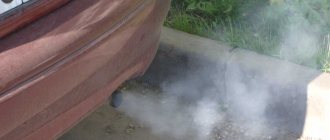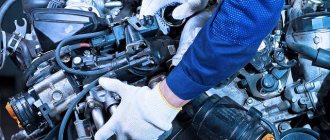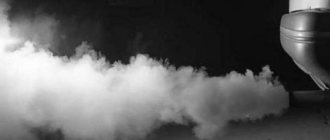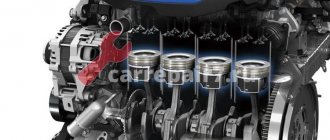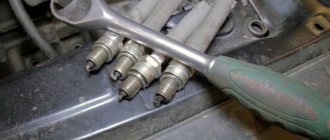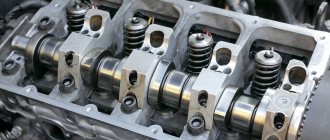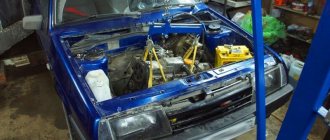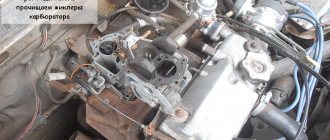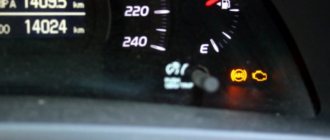Quite often you notice that increased smoke appears from the exhaust pipe of a car. Sometimes situations are similar to pictures from old movies, in which a steam locomotive is enveloped in clouds of smoke. The appearance of excessive smoke brings anxiety to every motorist. Then an intensive search begins for answers to the question of why the engine smokes.
Increased smoke often becomes an indicator of serious engine malfunctions. The symptoms apply to gasoline and diesel engines. Experienced motorists are able to make a fairly accurate diagnosis based on the color and characteristics of the exhaust. And having determined the essence of the problem, it is easier to deal with it.
Smoke color as an indicator of car problems
Exhaust gases are constantly released into the atmosphere through the exhaust pipe of a car. With a working engine, this happens almost imperceptibly and in minimal quantities. However, already at the initial stage of serious breakdowns in the power unit, exhaust emissions can become abundant, painted in various colors.
Under some circumstances, the appearance of smoke is combined with the following symptoms:
- starting a cold engine is difficult;
- the engine runs unstably at idle or under load;
- tachometer indicators become floating or jumpy;
- fuel or engine oil consumption increases noticeably;
- there is a loss of engine traction power.
Increased smoking of a cold or hot engine is the first, and sometimes the only sure sign of a power unit failure. The characteristic color of the exhaust helps to more accurately diagnose malfunctions, identify the severity of problems, and the various stages of their progression.
Why does the engine smoke white smoke with a blue tint?
Among the reasons why the engine smokes heavily with bluish or bluish smoke are:
- Wear and hardening of oil seals.
- Occurrence of oil scraper rings, their wear.
- The turbine is faulty.
Why does a gasoline engine smoke when cold?
If a car owner asks this question without doing anything to diagnose it, the severity of the breakdown increases every day. Immediately after the engine has been started, large clouds of smoke can be observed, but as soon as the car warms up, the amount of smoke decreases. The fact is that the valve stem seals begin to soften due to rising temperatures. The caps quickly become unusable due to too much clearance in the valve bushings, poor quality of the material from which they are made, as well as a large volume of crankcase gases due to severe wear of the cylinder-piston group.
The quality of the material used to create valve stem seals plays a key role.
With this problem, the oil scraper rings do not remove the oil film, and accordingly, too much oil enters the cylinders. This is why the engine will “eat” oil in large volumes. One possible solution is to decarbonize the oil scraper rings. However, after such a procedure, the engine requires careful attention, since the rings will lose their spring properties. As a result, the oil scraper rings will stick again.
It is more difficult to determine the reason why the engine smokes when the lower rings are stuck. In this case, there will be nominal compression, and since the upper rings are working, decarbonization will not get rid of the problem.
In particular, the CPG may wear out or the compression rings may jam. This happens when the oil scraper rings are not stuck, but are worn out in friction pairs.
All this explains why the engine smokes a lot. The volume of gas that goes through the recirculation system is much more than it should be. How to determine what the reason is? Open the oil filler neck when the car is started and idling. If the cylinder-piston group, as well as the crankcase gas recirculation system, operate without breakdowns, then the air flow will flow into the neck or slightly out of it. You can verify this with a piece of paper. When crankcase gas comes out of the neck at high speed, this means that the unit needs to be repaired. Look at the color of the gas coming from the oil filler neck. When the engine is in good working order, it should not have any tint.
Why does the engine smoke when hot if it has a turbocharger installed? If the turbocharger is faulty, oil is thrown into the turbine. That is, the oil that should go to the turbine bearings gets into the intake tract due to broken seals (usually turbine shaft seals).
Such a breakdown can be identified quickly. Simply remove the air duct that runs from the turbine to the motor at the lowest point. See if there is oil inside or not. Typically, a thin white woven material is placed in the pipe in front of the throttle. Install the pipe. Then press the accelerator pedal several times and check the fabric. If there are oil stains on it, it means the turbine is broken.
Why does an engine (diesel or gasoline) still produce bluish smoke?
- The crankcase gas recirculation system is clogged.
The engine is designed so that there is a constant vacuum inside it. This is ensured by vacuum in the throttle area, as well as by vacuum pumps (in some cases). One way or another, the crankcase gases that have been pumped out are sent to the intake manifold. However, the crankcase does not contain gas directly, but a kind of mist with oil droplets. Therefore, before the gases are discharged into the intake manifold, they are separated. This is what the crankcase gas recirculation system is designed for. When it is faulty, oil microparticles enter the intake along with the crankcase gas. This is the answer to the question why the engine smokes a lot.
- Poor quality oil.
The quality of the oil used plays a key role. If you purchased counterfeit oil, its characteristics will be impossible to determine. No one knows how it will behave during separation in the crankcase gas recirculation system, or how it will react to elevated temperatures in the cylinders.
In addition, it may simply overheat. And if this happens, it will lose its lubricating properties. Professional racers understand this, so they install oil temperature sensors in the engine, additional coolers, and the like. It is clear that such elements are absent in a factory-equipped car. An ordinary car is not designed for extremely high loads. And, as you know, cooling of the bottom of the pistons occurs precisely due to oil.
Of course, during quiet operation the oil will not overheat. But imagine: in thirty-degree heat you go to the dacha. Your whole family will sit in the car, and the trunk will be filled to capacity. At the same time, the engine is hidden under protection (after all, in some regions it is impossible without it), which will not allow the oil in the crankcase to cool. In addition, if you drive uphill, all of the above will 100% lead to overheating of the oil. Now you will have to fill in new engine oil.
- The spark plug wells are deep.
If the engine of your car is 16-valve, then its main drawback is deep spark plug wells, in which there are many joints of related parts. Moreover, one joint goes through oil, the other through air. Sometimes oil flows from the well into the suction pipe of the engine. Eventually the engine starts to smoke. How can you be sure that this is the reason? Remove the spark plug tips. Did you see oil on them? It follows from this that laying spark plug wells does not fulfill its purpose. Add to this the fact that the intake manifold is leaking, and you will answer your question why the engine smokes.
In addition to all of the above, the appearance of smoke can occur due to non-standard breakdowns. For example, why else does the engine smoke white and smell like oil?
The reason is a small crack in the motor, which is not easy to detect. Through it, oil flows into the intake or into the cylinder, and an oil leak occurs.
It also happens that the owner of the car uses fuel for two-stroke engines (with the addition of oil). And then he asks why the engine smokes when cold or hot.
We recommend
“Car stands on the roads: 11 most popular” Read more
Smoke transparency (white exhausts)
Transparent or whitish exhaust most often appears immediately after starting the engine or when the engine is not warmed up to operating temperature. Actually, this is the reason for the appearance of such exhausts. In a similar way, the power unit reacts to idle time. In winter, after a frosty night of inactivity, most cars' exhaust pipes emit clear or whitish smoke. But, in essence, it is steam.
Clear smoke is not a reason to panic
As the engine and the entire gas distribution system warm up, the amount of smoke will decrease. At very low atmospheric temperatures, steam remains noticeable even when the engine is running well. The density of such emissions is additionally affected by air humidity. Increased performance increases the amount of transparent smoke from the exhaust pipe.
It is quite easy to verify that the transparent smoke easily dissipates and is vapor. A simple experiment will prove that the motor is not experiencing serious problems. A clean paper sheet is applied to the exhaust pipe. After a certain time, it will dry out, and the exhaust condensate will not leave distinct dirty, greasy or oily stains. You can attach a container to the back of the muffler. Condensation forms on its walls when the engine is running.
Transparent smoke may be accompanied by the appearance of droplets from the exhaust pipe. This is not something to be afraid of. Condensate accumulated inside the system is released. The situation does not become a reason for panic; the engine does not require intervention or repair.
How to solve a problem
Once the cause of the problem is determined, you can begin to fix the problem. In addition, you can handle the repairs yourself, if the matter does not involve global relocation.
Clean the chimney
Chimney cleaning must be carried out regularly, even if expensive firewood is used. To carry out the procedure, use a brush with a weight (no more than 2 kg) on a strong cable. A weight helps knock pieces of brick to the bottom, and a brush cleans soot from pipes and wells.
We invite you to familiarize yourself with Installing a stove in a bathhouse with an external firebox
Important! If the owner leaves the house for a long time, it is necessary to close the pipe damper, which will prevent the deposition of soot inside the structure.
When craftsmen make design inconsistencies, the stove quickly fails and begins to smoke. Such violations are costly for the owner, since correcting the problem requires relocating the stove. Only a specialist can perform such complex work.
Cracks that appear as a result of overheating or long service life can be repaired yourself. To do this, use stove mortar, which is usually used for laying Russian brick stoves.
The procedure is as follows:
- Make a solution of sand and clay in a 1:1 ratio. You need to add a few teaspoons of water to the mixture. The solution should be thick.
- Moisten each crack with water before sealing.
- You should seal the gap inside the stove with your hand so that the mixture does not spill inside the structure. You can use a piece of metal for this.
- From the outside, the gap is sealed with mortar using a brush and spatula.
Clean the oven
The easiest way to clean the unit is not with a brush, but with special products that are sold in hardware stores. The Smoke log works well.
Before use, you only need to remove the film. The log is placed in the fired oven. The desired cleanliness effect is achieved in 2 hours.
Whiteness of smoke
After warming up the engine in warm weather, a thick white cloud may appear from the exhaust pipe. It indicates that coolant has entered the cylinders. This happens due to a leak in the gasket between the cylinder block and the head, or cracks in the coolant passages.
It is worth paying attention to other possible causes of white smoke. With the engine turned off, check for exhaust gases entering the cooling system. To do this, remove the expansion tank cap or unscrew the radiator cap. This determines:
- presence of exhaust odors;
- is there an oily film in the liquid itself;
- Is the coolant level low?
When starting the engine, you may experience an increase in the amount of liquid in the tank, the appearance of bubbles, and seething. All these signs will indicate that exhaust gases are entering the cooling system.
The entry of gases into the cooling system leads to an increase in pressure. After the engine stops, the coolant partially goes into the cylinders. Its level in the tank decreases. Antifreeze (antifreeze) seeps through the piston rings into the oil pan. There it mixes with motor lubricant, diluting it. A kind of emulsion is formed. Motor oil changes color, becomes cloudy, and loses its working properties.
Experienced technicians advise flushing the inside of the engine with diesel fuel before repairing such damage. This saves nerves and time during repairs. A cleaned motor will make it easier to locate the fault.
Additionally, diagnosing the condition of the oil filler plug and cylinder head cover helps ensure that coolant penetrates into the lubrication system. A light foam with a yellowish tint forms on their inner side. A similar sign can be recorded on the oil dipstick.
Low-quality antifreeze can provoke internal corrosion of metal engine parts. Sometimes the damage becomes through, and rust particles get into the expansion tank. Significant funds will be required to restore such an engine.
Engine overheating is a prerequisite for the appearance of white smoke.
The reasons for the appearance of abundant white smoke often lie in engine overheating. Ineffective operation of the system responsible for cooling the engine leads not only to overheating of the power unit, but also to deformation of the piston rings. The consequences require an immediate response and immediate troubleshooting.
If there is white smoke, you will definitely need to check the condition:
- problem cylinder;
- thermostat;
- fan and sensor for turning it on;
- expansion tank plugs;
- intake manifold gaskets;
- cooling system hoses;
- radiator tightness.
To determine the problem cylinder, you need to unscrew the spark plugs. In a faulty cylinder, the presence of coolant will make itself known by scale on the electrode. This coating is in many ways similar to what is found inside a teapot.
Liquid may enter the combustion chamber. This leads to the formation of air pockets and a large amount of liquid entering the cylinders. The consequence may be water hammer. Then pressure surges lead to the formation of cracks in the body of certain parts and damage to various equipment elements.
Having established the specific reasons for the appearance of white smoke from the exhaust pipe, repairs should be started immediately. The consequences of malfunctions will have to be eliminated in the operation of the entire cooling system.
Why does the new stove smoke?
What to do if a new stove smokes? In most cases, the cause is design miscalculations and violations of masonry technology. The heating furnace must have the following parameters:
- The chimney opening is 14*27 cm (firewood, peat) or 14*14 cm (coal).
- The height of the chimney is 6 cm from the stove grate to the top.
- The height of the pipe above the roof is at least 70 cm, but at least 50 cm above the ridge. The exception is when the ridge is located at a distance of more than 1.5 meters - then the pipe can be made of the same height.
The cause of smoke may be a pipe that is too narrow
If the internal dimensions of the chimney can only be corrected by a professional stove maker, then you can try to solve problems with the pipe yourself:
- Explore the area surrounding the house. If there are tall trees or walls nearby, the wind can blow into the chimney and drive smoke indoors. In this case, you need to put a cap on the top of the pipe, and with a 90% chance the problem will be solved.
- A stove in a house or bathhouse may smoke due to insufficient chimney height. Ideally, it needs to be increased, but this is not always realistic. If the heating season has already begun, you can lengthen the pipe using improvised means by placing one or two metal buckets without a bottom on it. This design does not look very aesthetically pleasing, but it will last through the winter.
Scheme for determining the height of the chimney
The service life of the furnace and its uninterrupted operation depend on how correctly it was put into operation. After completion of the masonry, a lot of moisture remains in the materials, which must be removed before the start of the heating season. The drying period lasts 7-10 days in the warm season and up to 3 weeks in the cold season. The process takes place in several stages:
- Open all valves and constantly ventilate the room in which the oven is located. Drying should continue until wet spots disappear from the walls and condensation stops appearing on metal parts.
- After 5-6 days, light a small fire in the morning and evening. Gradually increase the volume of firewood.
- Do not try to speed up the process by using too active a firebox. Overheating can lead to cracks and crevices in the masonry.
Pine logs
Laying the blower and constructing a transverse wall in the firebox.
We have figured out the reasons why old stoves may smoke. Now let's try to figure out why a new, recently built stove smokes. This can only happen as a result of some constructive miscalculations of the stove maker who built it.
Here is the most common miscalculation: the stove maker put the stove together, tested it, the fire in the stove hummed happily, everything was fine. On the second day you melted it, but it smoked. It's simple: yesterday the weather was calm, but today it's windy.
Go out into the yard and look around the house. If there is a high wall near it or trees grow higher than the roof of your house, you can assume with 90% confidence that you have found the cause of the mysterious phenomenon. The wind, hitting an obstacle such as a ball, bounces off it and ricochets into the chimney, driving the smoke inside.
What to do in this case? There is hardly any need to dismantle the wall, especially if it is a neighbor’s one. And it’s not worth cutting down trees either. It will be much easier and cheaper for you to put a cap on the chimney. In any case, it won’t hurt, but first, do a little experiment: place two bricks on top of each other at the corners of the pipe, and place an iron basin on them. If the stove stops smoking, then put on the cap and the problem will be solved.
Drawings or diagram for making a waste oil furnace.
But what if the chimney continues to smoke? This can happen if the chimney is installed below the required level, i.e. below 25 cm of the roof ridge, if the pipe is installed on the ridge or in close proximity (up to 1 m) from it. In this case, the pipe will have to be extended.
We invite you to familiarize yourself with Metal stoves - 120 photos, reviews and characteristics of metal models
The simplest way, although not very aesthetically pleasing, is cheap and practical, especially if the cold weather has arrived and the stove needs to be heated constantly, and there is no way to do repairs yet - put one or two iron buckets without a bottom on top of the pipe, thereby lengthening the pipe and improving traction. This design will not be durable, but it will definitely serve the heating season. And in warm weather, you can start extending the pipe thoroughly.
Sometimes it happens that smoke in a newly built stove begins to seep through the soot cleaner doors that are not tightly closed - either they came across a defective one, or they were installed by the stove maker according to the principle: askew, crooked - as long as it’s alive. In this case, it is better to fill the hole with a piece of brick, you can do it dry, but it is better to put it on a clay mortar for reliability and better sealing.
To eliminate most of the above reasons, you will need the following tools:
- Master OK;
- spatula for mixing the solution;
- bucket for solution;
- a double-sided mason's hammer (on one side it is a regular flat hammer, and on the other in the form of a pick for breaking bricks).
If it happens that everything is normal at first glance, but the new stove continues to smoke, then, most likely, its smoke channels are folded incorrectly or the diameter of the chimney is insufficient. In this case, you won’t be able to do anything yourself, so grab the would-be master who made your stove by the collar and let him correct his mistakes. And whether to pay him for this work or not - decide for yourself.
Good luck to you! Warmth and comfort to your home!
Bluish-gray smoke
The appearance of such smoke indicates that an excess amount of engine lubricant has entered the cylinders. If not everyone can determine the shade of the smoke, then paper is applied to the exhaust pipe. Confirmation of the problem situation will be greasy stains remaining on the sheet.
The bluish-gray clouds are quite dense. They take longer to disperse into the environment. They are accompanied by a characteristic and persistent smell of burnt motor oil.
Such circumstances prompt regular checking of the oil level. Its significant consumption (more than 0.5 liters per 1000 km) will confirm the presence of malfunctions.
The engine smokes with a bluish-gray color, indicating typical breakdowns:
- wear or loss of elasticity (tanning) of the valve stem seals;
- sticking or wear of oil scraper rings;
- turbine malfunction;
- wear of parts of the cylinder-piston group;
- clogging of the system that recirculates crankcase gases;
- low quality motor oil;
- malfunctions in the area of deep spark plug wells (16-valve engines).
The history of car enthusiasts has recorded curious cases, as a result of which bluish-gray smoke appeared from the exhaust pipe. So, some car owners filled the tank with fuel for two-stroke engines. This type of fuel is specially mixed with oil. Then the search for the causes of smoke is extended until the fuel that was poured in by mistake is completely burned.
Diagnosis of faults in engines with turbochargers
A poor turbocharger condition often manifests itself through bluish-gray smoke. Lubricating fluid is automatically supplied to the turbine bearings. Under a certain set of circumstances, oil intended to ensure normal operation of the turbine enters the intake tract. So, when burned, excess oil turns into bluish-gray smoke.
To more accurately diagnose problems associated with the functioning of the turbocharger, certain operations should be performed. Remove the air duct connecting the motor and turbine to check for the presence of oil inside. The presence of grease indicates that the problem is advanced and that serious repairs are necessary.
Therefore, at the first suspicion of excess oil appearing in the turbine, you must:
- take a clean, lightweight cloth that is highly permeable to liquid and air (for example, gauze);
- stretch the fabric on the throttle pipe;
- start the car;
- press the gas pedal several times with sufficient force;
- turn off the engine;
- check the condition of the fabric.
Traces of oil that appear on the fabric indicate an early stage of the problem. Resolving such a situation is much easier than in its neglected state. It is worth considering that malfunctions of one unit or system lead to disruption of the normal operation of other elements and components.
Why does the old stove smoke?
If an “aged” stove smokes, the reason may be trivial - during operation, the vent became clogged with ash, and the draft worsened. In this case, it is enough to remove the accumulated deposits with a poker. If a simple manipulation did not help or there was no ash, you will have to carefully check the entire system.
The stove must be regularly cleaned of ash.
Most often, the cause of smoke is non-compliance with operating rules, as a result of which natural air exchange is disrupted:
- Accumulation of soot in smoke ducts, pipes or furnace ducts. A layer only 3 mm thick reduces heat transfer by almost half, impairs traction and can lead to a fire. You can carry out general cleaning yourself - take a thick wire or pole, tightly wrap one end with an unnecessary rag, lower the structure into the pipe and thoroughly clean the walls. If there is little soot, you can use special compounds. They are added to the firebox along with firewood, and during the combustion process, volatile compounds are released that destroy contaminants. The simplest and most inexpensive option is a handful of coarse salt.
- Damp chimney. If the oven has not been used for several months, condensation may accumulate in the system. In this case, it is necessary to open the lower soot cleaning and light a small fire in it from flammable materials. Dry wood chips, paper or dry alcohol tablets are suitable as raw materials. After the chimney has warmed up and the draft has been restored, you can close the damper and light the stove.
- Using the wrong type of fuel. Why does a coal stove smoke into the house if it is heated with wood? The reason is a large difference in temperature. In stoves designed for coal, the length of the ash chamber is equal to the size of the firebox. When laying firewood, the cold air does not have time to warm up and returns to the room, bringing with it the smell of burning and soot. To solve the problem, it is enough to shorten the blower by laying halves of bricks on its end (the number depends on the total length).
Firewood must be stacked in even rows
Appearance of defects
What to do if all visible causes have been eliminated, but the stove still smokes? Another reason for insufficient draft can be cracks in the walls of the chimney and/or combustion chamber. Cold air enters the oven through the cracks, lowering the temperature. The fuel burns worse and produces a lot of smoke.
If a “cobweb” of small, non-through cracks appears on the walls, you can eliminate it yourself:
- Clean the surface by widening the cracks with a chisel.
- Prepare a liquid primer from cement with water and coat the walls thoroughly.
- While the surface is drying, prepare a clay solution for plastering. The classic recipe includes 2 parts clay and 1 part sand. To increase strength, you can add 0.1 parts of asbestos. The resulting mixture is sifted through a fine sieve and mixed with water until a thick consistency is obtained.
- Fill the cracks with a triangular trowel, level the surface and float with a wooden float.
- Let the plaster dry and apply the finishing layer to the entire wall, moving from bottom to top.
- Wait for the mixture to dry, moisten a wooden grater in water and rub in any unevenness using smooth circular movements.
Cracks in the brick and crumbling seams are the reason why the stove smokes
Another reason why a stove in a bathhouse or house smokes can be a loose brick. Under the influence of a constant temperature difference, cracks form in the masonry of the first channels of the chimney or firebox, the mixture crumbles, and the bricks remain loose. It is better to shift such areas:
- Select high-quality bricks with the smoothest walls possible.
- Carefully remove damaged bricks from the masonry and remove any remaining old mortar from the recess. Clean the surface with a metal brush.
- Apply the clay solution to the prepared surfaces, paying special attention to the bottom of the recess.
- Lay new brick. If trimming has been done, make sure that the smooth side is directed towards the exhaust gas outlet.
Special mastics can be used to coat ovens
It often happens that a stove that has served faithfully for years, giving the home warmth and comfort, suddenly begins to cause a lot of inconvenience to its owners. After all, if there is a problem with the stove, there is no longer any need to talk about warmth in the house, and even more so about comfort. What kind of comfort is there if everything in the house is saturated with the smell of smoke! It’s time to shout “guard” and urgently run in search of a stove maker to repair it.
Sectional view of the stove.
But don't rush. Let's first look at all the possible options for why the stove smokes.
We suggest you read: How to lay soft tiles on a roof
The reason may be trivial, for example, a vent clogged with ash. In this case, it is enough to clean the ash pit by removing the ash from it, and the stove will literally sing joyfully with relief.
Vertical section of the furnace and laying rows.
To complete this work you will need:
- a poker to remove ash;
- a scoop to collect the ash;
- a bucket or basin to take out the ashes.
But what if the vent is clean, or the ash has been removed, but the stove still smokes? Then let's look further. You need to check the smoke ducts, hog and chimney. Deterioration in traction can also occur due to soot deposits in them. After all, a 3 mm layer of soot reduces the heat transfer of the furnace by almost half, which leads to significant excess fuel consumption. And don’t forget about fire safety: a layer of soot not only impairs traction, but can easily catch fire.
Therefore, in any case, it will not be superfluous to clean the pipes and smoke channels from the soot accumulated there. It won’t be a big deal, and you don’t need expensive tools. Take a pole or thick wire, tie a rag or brush to one end, lower this structure into the pipe and clean the walls with it.
If the soot layer is small, you can do it easier by using chemicals that remove a significant part of the soot during combustion. A little secret: you don’t have to go far to get them, just throw a handful of ordinary salt, but always coarsely ground, onto the burning coals.
Ordering the oven.
If the stove has not been used for several months, the chimneys may become damp. They need to be thoroughly dried before lighting the stove. To do this, you need to open the lower soot cleaner and make a small fire in it, using flammable and quickly burning materials, such as paper or wood chips.
If the stove was built to use coal as fuel, and because of its high cost you switched to using wood, the stove may start to smoke. This happens because the temperature when burning coal and wood differs. The blower in such a stove is made the length of the entire firebox, so that there is better airflow and the coal can burn.
To solve this problem, it is enough to shorten the ashpit by inserting one or two halves of brick into its end, depending on the length, having previously adjusted them to the required size.
Blackness of smoke
The black exhaust that appears can also tell you why the car is smoking. Shades of smoke range from dark gray to deep black. They indicate excessive enrichment of the fuel-air mixture. The alarming color is caused by soot particles that are released into the atmosphere due to inefficient fuel combustion.
Most often, black smoke indicates problems with the fuel supply. They can be identified by paying attention to direct or indirect signs:
- difficult starting of the power unit;
- unstable operation of the motor;
- high toxicity;
- noticeable increase in fuel consumption;
- the engine loses power;
- the catalyst fails.
Black smoke is a consequence of the fact that not all the fuel has time to burn out in the cylinder-piston group. If you delay repairs in such cases, the results can be very disastrous. In case of serious damage to the cylinder-piston group or other components of the power unit, expensive repairs may exceed the price of the car itself.
The reasons for the appearance of black smoke vary depending on the technical equipment of the car. Engines equipped with carburetor injection smoke black due to fuel overflow in the float chamber. In such situations, it is necessary to check the needle valve and jets responsible for the air supply.
When using fuel injection, the mixture is over-enriched due to failures of electronic sensors. The possible loss of tightness of the injectors themselves should not be excluded from the list of reasons. If the injection nozzles cannot cope with fuel dosing, then excess fuel enters the combustion chambers. Excess fuel moves into the crankcase and washes away the oily protection from the cylinder walls.
Often black smoke is accompanied by a lingering smell of fuel. This is another sign of fuel getting into the engine oil. You can double-check this sign by measuring the lubricant level. An increase in the amount of oil indicates its dilution with fuel.
Specifics of diesel engines
Black smoke escaping from the exhaust pipes of diesel or turbo diesel engines is a consequence of poor fuel quality. Other reasons worth considering are:
- wear of injectors;
- severe contamination of the air filter;
- malfunction of the speed controller in the fuel injection pump;
- failure of the high pressure fuel pump (HPF);
- turbine breakdowns.
The injection pump is one of the most complex components in the entire fuel supply system with which diesel engines are equipped. For efficient operation of the fuel pump, the lubricant contained in diesel fuel is necessary. Low grade fuel does not have the properties to ensure reliable operation of the fuel pump. Therefore, this important assembly unit may fail prematurely.
The appearance of a smoky plume of white, gray or black shades is a serious reason to seek help from car service specialists. Procrastination and putting off solving the problem leads to higher repair costs and the creation of unpredictable situations on the road. By carefully looking at the color of your exhaust, you can prevent many problems. Timely diagnosis of the causes of malfunctions will help maintain the car in good functional condition.
Valve seals or rings: how to determine what caused the blue smoke
If you've done a quick study of the issue, you've probably noticed that there is a lot of conflicting information. For example, there is a lot of controversy around the same compression: some argue that with normal pressure in the cylinders there is no reason to go into the piston, others insist that this is not an indicator at all in the current situation. And regarding the relationship between the engine temperature, the position of the gas pedal and the time of appearance of bluish smoke, it is not at all clear what’s what.
Let us immediately note that there is no connection between compression and defective oil scraper rings. Firstly, the rings that scrape oil from the cylinders wear out or become stuck first, while the compression rings continue to work as expected. Secondly, even with slightly worn compression rings and damaged oil scraper rings, compression will be normal, since the oil remains on the cylinder walls.
At the same time, unspoken differences exist that make it possible to determine what exactly has failed: caps or oil scraper rings. The difference is that each group of parts produces blue smoke at different intervals.
Symptoms of problems with caps
The following test will help you accurately judge the caps for replacement:
If there are problems with the seals, in the first seconds of the “gas to the floor” mode, a cloud of smoke with a bright bluish tint flies out of the muffler. For extra confidence, repeat the attempt to throttle to failure 2-3 more times. Observations are such that in subsequent cycles the puff of smoke will lose saturation, and may even disappear altogether.
For your information. The most reliable diagnosis is considered to be based on the color of the exhaust, in which “gas to the floor” is given after warming up and running the engine at operating temperature for 5-7 minutes. The bluish tint under such conditions turns out to be much more saturated than during the morning start and other gas conditions.
What explains this prioritization? If the cap is worn, oil will flow down the valve stem when the engine is running. Whether it will accumulate on the valve plate or immediately enter the cylinders is determined by the angle of the throttle valve. So, at idle, the speed of the air mass is low, the oil is not removed from the plate, but continues to accumulate. As soon as you sharply (it is important to press this way) press the gas pedal, air or the fuel-air mixture (depending on the type of fuel injection) draws the accumulated oil emulsion into the cylinders and it burns, forming a bluish smoke.
There will be no ominous tint at revs, and, in fact, there shouldn’t be. The oil does not have time to accumulate, but immediately enters the cylinders and burns in small fractions, which is why it does not affect the color of the exhaust gases.
It is worth noting that with a new catalyst, the color of the exhaust may not change at all, since it qualitatively converts CH into water vapor. On a half-dead catalytic converter or installed flame arrester, the picture appears in all its glory: there is smoke.
How to determine whether oil rings are faulty
Worn rings make themselves felt when under load. In reality, it looks like this: the color of the exhaust gases changes when moving uphill with the gas pedal half-pressed. It is worth noting that looking in the rearview mirror, you are unlikely to draw the right conclusion. The puff of smoke usually dissipates quickly. However, the driver of the car behind may well record his appearance.
For your information. There is an opinion that the initial stage of wear should be determined during gear shifting. If bluish smoke appears at this moment, the rings will need to be replaced soon.
When the rings are worn critically, smoke comes out constantly while driving and regardless of the terrain under the wheels. In addition, an increase in smoke is observed with increasing speed.
What else could cause a bluish-colored exhaust?
A defective turbine and faulty crankcase ventilation can also cause smoke. What distinguishes these failures from current caps or oil rings is the nature of the smoke: there is a lot of smoke + it can appear and disappear at any time. For example, the engine runs smoothly at idle and suddenly starts smoking, and after 3-4 minutes it stops.
Black diesel exhaust: main reasons
One of the most harmless causes of black smoke is the low quality of diesel fuel (fuel cetane number) in the fuel tank. The color of the exhaust gradually normalizes after immediately switching to better diesel fuel.
Diesel with poor fuel usually produces gray-black exhaust. Also, the reason for the appearance of a small amount of soot in the exhaust is clogging of the engine exhaust system. In other cases, the presence of black smoke from a diesel exhaust pipe indicates that:
- there are problems in the fuel or air supply system of the diesel engine;
- conditions for optimal combustion of the mixture are violated (often due to wear of the CPG);
- possible malfunctions of the gas distribution mechanism;
The appearance of black diesel exhaust is often caused by a clogged air filter or difficult air entry into the intake air tract, inaccuracies in adjusting the valve clearances or failures in the valve timing. A common cause is engine wear and low cylinder compression. Black diesel exhaust also appears when there is a malfunction of the boost pressure adjustment system, malfunctions in the fuel injection pump or injectors (low fuel injection pressure, change in the shape of the diesel fuel spray pattern, unsuitable diesel injectors installed).
Low compression
Among the main reasons why diesel fuel does not burn completely is a drop in compression in the cylinders. At low compression, a diesel engine has a clearly visible black exhaust. In a diesel engine, the pressure created at the end of the compression stroke plays a key role. The efficiency of self-ignition of the fuel-air mixture depends on the temperature of the compressed air at the time of fuel injection. With low compression, the temperature for complete combustion will not be enough, and the problem is most pronounced at sub-zero temperatures outside. A diesel engine with low compression often does not start in winter.
Fuel equipment
Diesel also produces black exhaust smoke as a result of fuel injection pump malfunctions, leaking diesel injectors, or too much advance of the injection angle. With a large advance (early fuel supply), severe detonation and increased noise may occur when the engine operates in different modes. The list of breakdowns of fuel equipment includes wear of injectors and irregularities in the spray pattern, failure of the speed controller in the high-pressure fuel pump. Prolonged driving on low-quality fuel quickly damages the fuel injection pump, since low-grade diesel fuel does not provide proper lubrication of the pump.
Turbocharger
Black diesel exhaust can also result from problems with the turbocharger, which does not develop the necessary boost for efficient combustion of the mixture. Lack of tightness in the intake tract often leads to black smoke coming out of the exhaust pipe of a diesel engine. In this case, such smoke can be seen at the moment of re-gassing. On a turbodiesel, the fuel supply increases during gas overload, but the boost pressure occurs with a delay as a result of the inertial rotation of the turbine. For this reason, there is not enough air in the cylinder for complete combustion of the fuel-air mixture, as a result of which the diesel engine smokes heavily.
Prolonged driving with an early injection angle or faulty diesel injectors can lead to burnout of the prechambers or destruction of the jumpers. Burning and destruction of the pistons is also likely.
